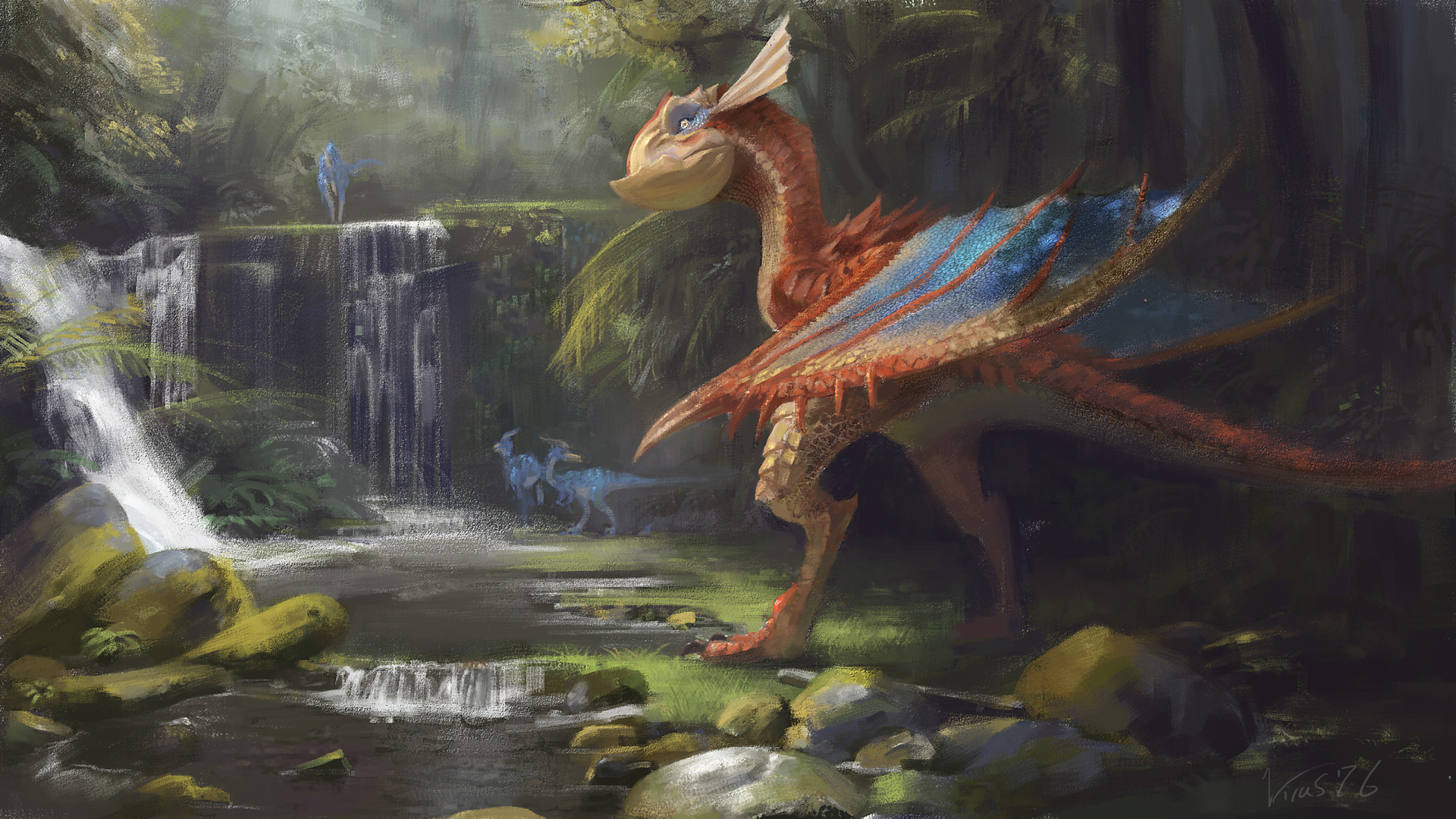
Table of Contents
-
Theropods
- 2Jaggi (CR 1/2)
- 3Jaggia (CR 1)
- 3Great Jaggi (CR 2)
- 4Baggi (CR 1)
- 4Great Baggi (CR 2)
- 5Wroggi (CR 1)
- 5Great Wroggi (CR 2)
- 6Velociprey (CR 1/4)
- 6Velocidrome (CR 1)
- 7Genprey (CR 1/4)
- 7Gendrome (CR 1)
- 8Ioprey (CR 1/2)
- 8Iodrome (CR 1)
- 9Giaprey (CR 1/2)
- 9Giadrome (CR 2)
- 10Maccao (CR 1/4)
- 10Great Maccao (CR 2)
- 11Kulu-Ya-Ku (CR 4)
- 12Tzitzi-Ya-Ku (CR 6)
-
Bird Wyverns
- 13Yian Kut-Ku (CR 3)
- 14Hypnocatrice (CR 4)
- 15Pukei-Pukei (CR 4)
- 16Qurupeco (CR 6)
- 17Yian Garuga (CR 7)
- 18Gypceros (CR 8)
- 19Malfestio (CR 9)
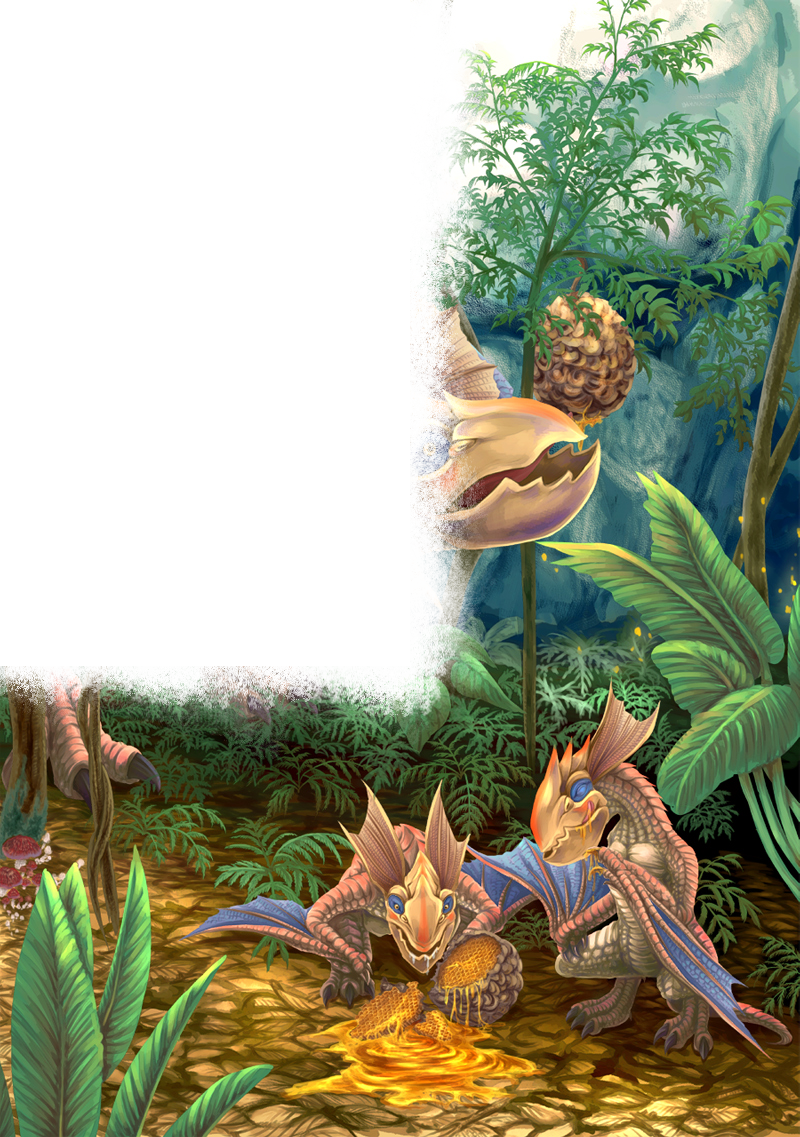
Bird Wyverns & Theropods
Bird Wyverns are, as their name implies, bird-like in nature, with slender delicate bodies. Despite their comparatively small stature, Bird Wyverns often use their agility to their advantage to neutralize attacks and prey alike. Flying Bird Wyverns exhibit similar characteristics to True Wyverns, with a bipedal stance along with developed and functional wings. Many of these possess a hard, sharp beak which can be used to peck at attackers, and generally behave in a bird-like manner.
Theropods are reminiscent of Brute Wyverns; flightless, bipedal creatures with long tails and powerful legs. Unlike Brute Wyverns however, these monsters are generally quite small. Furthermore, Theropods almost always live under a social hierarchy, with young individuals, females and beta males led by a strong, dominant alpha male, which can command and control his subjects during combat.
Jaggi
Jaggi are mostly pink, with purple foreclaws, back-stripe, and head-frills, and with cream-colored underbellies. Their tails are barbed along the length of the appendage, and they sport sizable frills sprouting from behind their jaws, possibly for making themselves look bigger to other monsters.
Though Jaggi and their kind display a higher functioning level of cooperation than other Raptors, Jaggi are often easily dealt with, even for novice Adventurers. This is due, in part, to their boisterous nature; Jaggi will often spend just as much time vocalizing bark-like warnings against intruders as they will attacking them.
Jaggia
Jaggia are the females of the Jaggi species. They are noticeably larger and bulkier than the immature males, and are mostly a blue-purple in hue, the exceptions being orange areas along their limbs and the sides of their necks and cream-colored underbellies. Their tails, unlike males of the species, have no barbs, and instead have a soft feather-like hanging accent near their ends. Their frills, located behind their jaws, are also more subdued than in other Jaggi variations, and hang limply.
Jaggia and their kin display a higher functioning level of cooperation than other small Bird Wyverns, and are more of a challenge than the smaller Jaggi due to their greater resilience and larger size. It is also notable that, unlike most other bird wyverns, Jaggia are sometimes found sleeping or lying down.
Great Jaggi
Great Jaggi's distinctive feature is its frill and the lavender scales with the crimson and tangerine overrides on the frills and the abdomen part, but also the furs that grow on its neck and along the back down to the middle tip of the tail. Great Jaggi's muzzle are particularly thinner and much more wrinkly than the other Bird Wyverns. While the tail has some barbs on each sides, they are notably blunt and definable even used for its tail whip attacks.
Great Jaggi, along with the Great Baggi, may attack other monsters instead of focusing solely on the Adventurer, indicating a highly competitive and intelligent demeanor. It can also call its pack of Jaggi to its aid at any time with a loud, resonating roar.
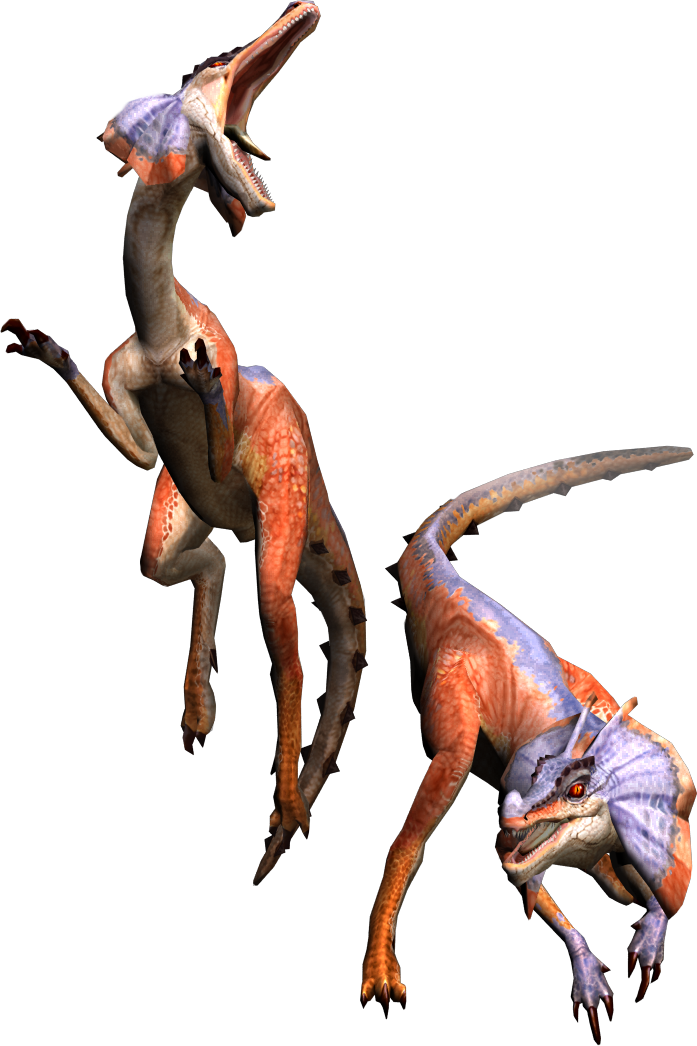
Jaggi
Medium beast (theropod), unaligned
- Armor Class 11 (natural armor)
- Hit Points 26 (4d8 + 8)
- Speed 30 ft.
STR DEX CON INT WIS CHA 15 (+2) 13 (+1) 14 (+2) 2 (-4) 8 (-1) 6 (-2)
- Senses passive Perception 9
- Languages -
- Challenge 1/2 (100 XP)
Pack Tactics. The Jaggi has advantage on attack rolls against a creature if at least one of the Jaggi's allies is within 5 feet of the creature and the ally isn't incapacitated.
Actions
Bite. Melee Weapon Attack: +4 to hit, reach 5 ft., one target. Hit: 5 (1d6 + 2) piercing damage.
Claw. Melee Weapon Attack: +4 to hit, reach 5 ft., one target. Hit: 7 (2d4 + 2) slashing damage.
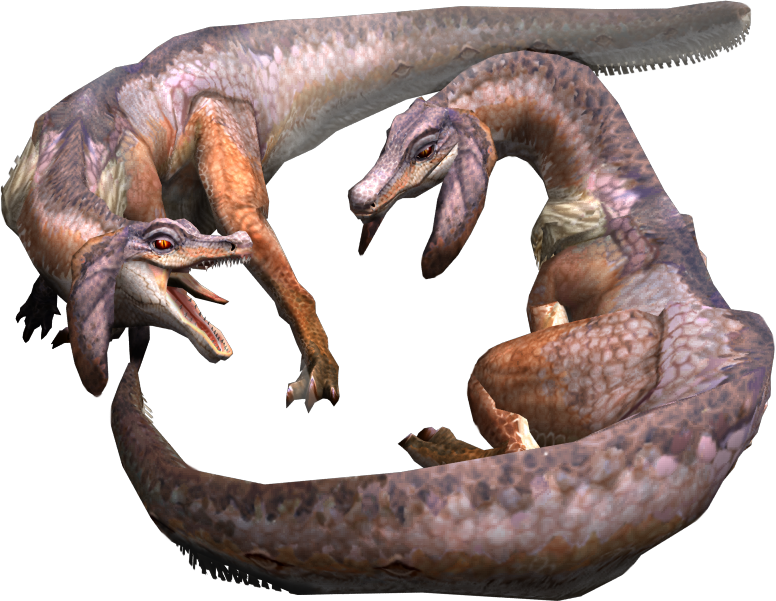
Jaggia
Medium beast (theropod), unaligned
- Armor Class 12 (natural armor)
- Hit Points 37 (5d8 + 15)
- Speed 30 ft.
STR DEX CON INT WIS CHA 16 (+3) 13 (+1) 16 (+3) 2 (-4) 10 (+0) 6 (-2)
- Senses passive Perception 10
- Languages -
- Challenge 1 (200 XP)
Pack Tactics. The Jaggia has advantage on attack rolls against a creature if at least one of the Jaggia's allies is within 5 feet of the creature and the ally isn't incapacitated.
Brute. A melee weapon deals one extra die of its damage when the Jaggia hits with it (included in the attack).
Actions
Bite. Melee Weapon Attack: +5 to hit, reach 5 ft., one target. Hit: 12 (2d8 + 3) piercing damage.
Slam. Melee Weapon Attack: +5 to hit, reach 5 ft., one target. Hit: 10 (2d6 + 3) bludgeoning damage. If the target is a creature, it must succeed on a DC 11 Strength saving throw or be knocked prone.
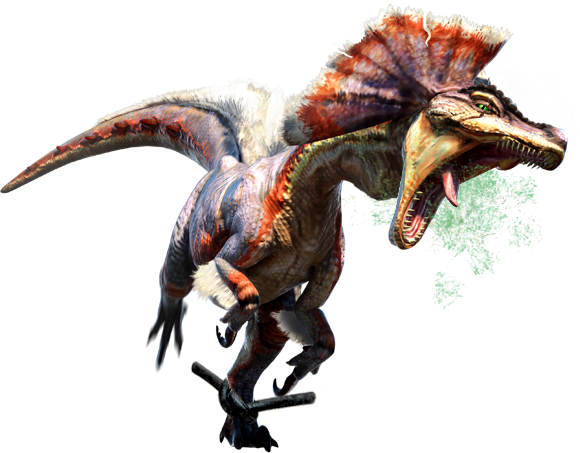
Great Jaggi
Large beast (theropod), unaligned
- Armor Class 13 (natural armor)
- Hit Points 59 (7d10 + 21)
- Speed 30 ft.
STR DEX CON INT WIS CHA 17 (+3) 13 (+1) 16 (+3) 2 (-4) 10 (+0) 6 (-2)
- Skills Athletics +5
- Senses passive Perception 10
- Languages -
- Challenge 2 (450 XP)
Brute. A melee weapon attack deals one extra die of its damage when the Great Jaggi hits with it (included in the attack).
Pounce. If the Great Jaggi moves at least 20 feet. straight toward a creature and then hits it with a slam Attack that knocks the target prone on the same turn. Then the Great Jaggi can make one bite Attack against it as a Bonus Action.
Actions
Bite. Melee Weapon Attack: +5 to hit, reach 5 ft., one target. Hit: 16 (3d8 + 3) piercing damage.
Slam. Melee Weapon Attack: +5 to hit, reach 5 ft., one target. Hit: 13 (3d6 + 3) bludgeoning damage. If the target is a creature, it must succeed on a DC 13 Strength saving throw or be knocked prone.
Alpha Call (1/day). The Great Jaggi calls out for help and 1d4 jaggi and 1d2 Jaggia appears to assist it.
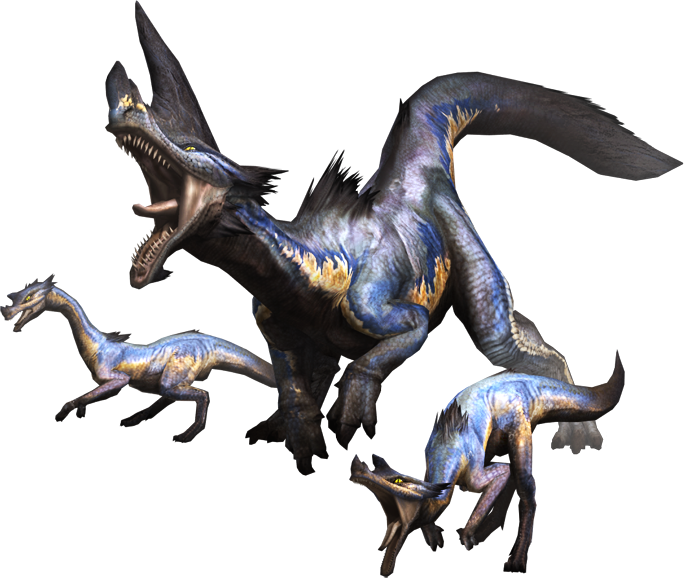
Baggi
Baggi behave the same way as Jaggi and Jaggia. Unlike Jaggi, however, they can be either male or female. They have the ability to put other creatures to sleep due to its special liquid spit when it bites, that only lasts a few seconds. Baggi have the same attacks as the creatures they resemble, the Jaggi, but attack more without delay. They will spend much less time hissing and will rush at Adventurers without warning. Like their relatives, the Jaggi, Baggi will attack other large monster in the same area, excluding the Great Baggi.
Baggi
Medium beast (theropod), unaligned
- Armor Class 11 (natural armor)
- Hit Points 26 (4d8 + 8)
- Speed 30 ft.
STR DEX CON INT WIS CHA 15 (+2) 13 (+1) 14 (+2) 2 (-4) 8 (-1) 6 (-2)
- Senses passive Perception 9
- Languages -
- Challenge 1 (200 XP)
Pack Tactics. The Baggi has advantage on attack rolls against a creature if at least one of the Baggi's allies is within 5 feet of the creature and the ally isn't incapacitated.
Brute. A melee weapon attack deals one extra die of its damage when the Baggi hits with it (included in the attack).
Actions
Bite. Melee Weapon Attack: +4 to hit, reach 5 ft., one target. Hit: 11 (2d8 + 2) piercing damage. If the target is a creature, it must succeed on a DC 12 Constitution saving throw or become Incapacitated for 1d4 turns or until they take damage.
Claw. Melee Weapon Attack: +4 to hit, reach 5 ft., one target. Hit: 9 (3d4 + 2) slashing damage.
Great Baggi
The Great Baggi's eyes will glow yellow in the dark. Great Baggi are matured male Baggi that have taken over a pack of their own. Great Baggi is also slightly larger than the Great Jaggi. Located on its head is a crest that is highly prized by merchants for its use in armor and weapon crafting. It has developed its own unique ability; it can spit a tranquilizing liquid that inflicts sleep on its prey or hunters. It also has developed the ability to command Baggi to surround prey or hunters and spit tranquilizing liquid at them with a roar.
Great Baggi
Large beast (theropod), unaligned
- Armor Class 13 (natural armor)
- Hit Points 59 (7d10 + 21)
- Speed 30 ft.
STR DEX CON INT WIS CHA 18 (+4) 13 (+1) 16 (+3) 2 (-4) 10 (+0) 6 (-2)
- Skills Athletics +6
- Senses passive Perception 10
- Languages -
- Challenge 2 (450 XP)
Brute. A melee weapon attack deals one extra die of its damage when the Great Baggi hits with it (included in the attack).
Pounce. If the Great Baggi moves at least 20 feet straight toward a creature and then hits it with a claw Attack on the same turn, that target must succeed on a DC 14 Strength saving throw or be knocked prone. If the target is prone, the Great Baggi can make one bite Attack against it as a Bonus Action.
Actions
Bite. Melee Weapon Attack: +6 to hit, reach 5 ft., one target. Hit: 17 (3d8 + 4) piercing damage. If the target is a creature, it must succeed on a DC 13 Constitution saving throw or become Incapacitated for 1d4 turns or until they take damage.
Claw. Melee Weapon Attack: +6 to hit, reach 5 ft., one target. Hit: 14 (4d4 + 4) Slashing damage.
Sleep Spit. The Great Baggi spits a sleepy concoction at a location within 60 feet All creatures within a 5 foot radius must pass a DC 13 Constitution saving throw or become incapacitated for 1d4 turns or until they take damage.
Alpha Call (1/day). The Great Baggi calls out for help and 1d4 Baggi appears to assist it.
Wroggi
Wroggi are similar in body structure to Jaggi and Baggi, and are covered in a slick, water-resistant hide of an orange colouration. They have a pair of poison sacs on either side of their heads. Their movements and body structure are similar to that of Jaggia. Wroggi are poisonous, but are not as strong or as resistant to poison as their leader.
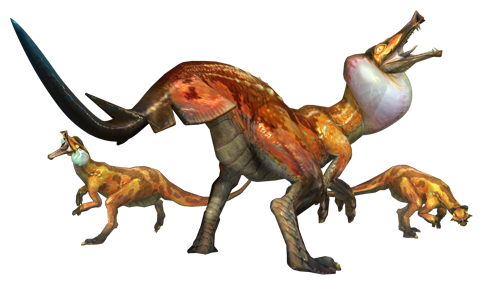
Wroggi
Medium beast (theropod), unaligned
- Armor Class 11 (natural armor)
- Hit Points 26 (4d8 + 8)
- Speed 30 ft., swim 30 ft.
STR DEX CON INT WIS CHA 15 (+2) 13 (+1) 14 (+2) 2 (-4) 8 (-1) 6 (-2)
- Senses passive Perception 9
- Languages -
- Challenge 1 (200 XP)
Pack Tactics. The Wroggi has advantage on attack rolls against a creature if at least one of the Wroggi's allies is within 5 feet of the creature and the ally isn't incapacitated.
Brute. A melee weapon attack deals one extra die of its damage when the Wroggi hits with it (included in the attack).
Actions
Bite. Melee Weapon Attack: +4 to hit, reach 5 ft., one target. Hit: 11 (2d8 + 2) piercing damage. If the target is a creature, it must succeed on a DC 12 Constitution saving throw or become Poisoned for 1d4 turns.
Claw. Melee Weapon Attack: +4 to hit, reach 5 ft., one target. Hit: 9 (3d4 + 2) slashing damage.
Great Wroggi
The Great Wroggi has a slick salamander-like skin and, like its close relatives the Great Jaggi and Great Baggi, Great Wroggi are usually accompanied by a group of their smaller kin. Strangely enough, Wroggi seem to possess two, light blue poison sacs on either side of their heads, while the Great Wroggi possesses only a single, much larger, purple poison sac under its throat. It is believed that the poison sacs grow as the male Wroggi matures until the two poison sacs join together to become one poison sac.
Great Wroggi
Large beast (theropod), unaligned
- Armor Class 13 (natural armor)
- Hit Points 59 (7d10 + 21)
- Speed 30 ft., swim 30 ft.
STR DEX CON INT WIS CHA 18 (+4) 13 (+1) 16 (+3) 2 (-4) 10 (+0) 6 (-2)
- Skills Athletics +6
- Senses passive Perception 10
- Languages -
- Challenge 2 (450 XP)
Brute. A melee weapon attack deals one extra die of its damage when the Great Wroggi hits with it (included in the attack).
Pounce. If the Great Wroggi moves at least 20 feet straight toward a creature and then hits it with a claw Attack on the same turn, that target must succeed on a DC 14 Strength saving throw or be knocked prone. If the target is prone, the Great Wroggi can make one bite Attack against it as a Bonus Action.
Actions
Bite. Melee Weapon Attack: +6 to hit, reach 5 ft., one target. Hit: 17(3d8 + 4) piercing damage. If the target is a creature, it must succeed on a DC 13 Constitution saving throw or become poisoned for 1d4 turns.
Claw. Melee Weapon Attack: +6 to hit, reach 5 ft., one target. Hit: 14 (4d4 + 4) Slashing damage.
Poison Spit. The Great Wroggi spits a poisonous concoction in a 5 foot area within 60 feet of it All creatures within a 5-foot radius must pass a DC 13 Constitution saving throw or become poisoned for 1d4 turns.
Alpha Call (1/day). The Great Wroggi calls out for help and 1d4 Wroggi appears to assist it.
Velociprey
Velociprey have blue scales with black stripes, and a dull red crest on their heads. These carnivorous monsters travel in packs and inhabit many different environments.
Velociprey have highly developed brains, and can come up with a hunting plan quite quickly. The Velociprey will use a range of calls to talk to each other in order to cooperate properly. They usually surround prey, giving it little ways to escape, and attack by using their foot claws and hand claws. If there is a large pack, they can take down prey bigger than young Aptonoth. Inside of a Velociprey's beak is number of sharp, thin teeth. Though the teeth look delicate, they are surprisingly hard to break. Even bombs can't break a Velociprey's teeth. Velociprey have powerful legs for used running at high speeds after prey with claws used to injure prey.
Velociprey packs are known to raid villages for food and will sometimes raid villages if food is scarce.
Velocidrome
The Velocidrome has a large, bright red crest over its blue hide signifies to other Velociprey that it is fit to be their leader. It is heavily set in its pack mentality and will rarely fight alone. To try to scare away potential predators, Velocidrome have colorful scales that act as warning colors. Velocidrome give orders to the Velociprey while it constantly patrols its territory in search of intruders that have entered it. If an intruder is spotted, the Velocidrome will call for its pack before attacking the threat.
Velociprey
Medium beast (theropod), unaligned
- Armor Class 11 (natural armor)
- Hit Points 26 (4d8 + 8)
- Speed 30 ft.
STR DEX CON INT WIS CHA 12 (+1) 13 (+1) 14 (+2) 10 (+0) 8 (-1) 6 (-2)
- Senses passive Perception 9
- Languages -
- Challenge 1/4 (50 XP)
Aggressive. As a bonus action, the velociprey can move up to its speed toward a hostile creature that it can see.
Actions
Bite. Melee Weapon Attack: +3 to hit, reach 5 ft., one target. Hit: 4 (1d6 + 1) piercing damage.
Claw. Melee Weapon Attack: +3 to hit, reach 5 ft., one target. Hit: 6 (2d4 + 1) slashing damage.
Velocidrome
Large beast (theropod), unaligned
- Armor Class 13 (natural armor)
- Hit Points 68 (8d10 + 24)
- Speed 40 ft.
STR DEX CON INT WIS CHA 17 (+3) 13 (+1) 16 (+3) 10 (+0) 10 (+0) 6 (-2)
- Skills Athletics +5
- Senses passive Perception 10
- Languages -
- Challenge 1 (200 XP)
Standing Leap. The velocidrome's long jump is up to 30 feet and its high jump is up to 15 feet, with or without a running start.
Aggressive. As a bonus action, the velocidrome can move up to its speed toward a hostile creature that it can see.
Actions
Bite. Melee Weapon Attack: +5 to hit, reach 5 ft., one target. Hit: 12 (2d8 + 3) piercing damage.
Deadly Leap. If the velocidrome jumps at least 15 feet as part of its movement, it can then use this action to land on its feet in a space that contains one or more other creatures. Each of those creatures must succeed on a DC 13 Strength or Dexterity saving throw (target's choice) or be knocked prone and take 6 (1d6 + 3) bludgeoning damage On a successful save, the creature takes only half the damage, isn't knocked prone, and is pushed 5 feet out of the velocidrome's space into an unoccupied space of the creature's choice. If no unoccupied space is with in range, the creature instead falls prone in the velocidrome's space.
Alpha Call (1/day). The velocidrome calls out for help and 1d4 velociprey appear to assist it.
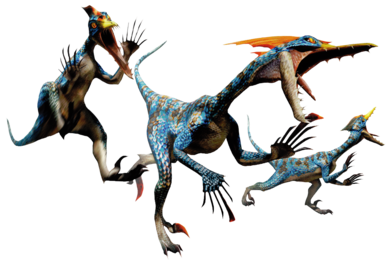
Genprey
Genprey bodies are covered in a colorful yellow and green hide, with a pair of yellow crests over their eyes. They are a mid-level hunter. They prey on Aptonoth and Apceros. Genprey are pack hunters, and often rely on plans formulated by their pack leader, the Gendrome.
Genprey are covered in scales used for both camouflage in the harsh deserts and repel the fangs of other creatures. If the other creatures have a type of paralyzing toxin, skin under the scales can neutralize the paralyzing venom. In their fangs, is a deadly venom that can paralyze prey ten times their own size. Its estimated that it takes near seconds for the venom to paralyze prey no matter what size.
Gendrome
adventurers can easily identify a Gendrome by their big crest and slightly larger size compared to a Genprey. The crest signifies leadership over the pack. With a pack to protect them and paralyzing fangs, they are a force to be reckoned with. Quick attacks and high speed allow them to attack with surprising power.
Gendrome are aggressive leaders that can repel some Flying Wyverns. Gendrome are well-known for occasionally living alone separate from a pack. In most cases, these are Gendrome searching for a pack to rule over, even if it means that they have to challenge that packs current leader.
Genprey
Medium beast (theropod), unaligned
- Armor Class 10 (natural armor)
- Hit Points 32 (5d8 + 10)
- Speed 30 ft.
STR DEX CON INT WIS CHA 13 (+1) 12 (+1) 14 (+2) 2 (-4) 8 (-1) 6 (-2)
- Condition Immunities paralyzed
- Senses passive Perception 9
- Languages -
- Challenge 1/4 (50 XP)
Aggressive. As a bonus action, the genprey can move up to its speed toward a hostile creature that it can see.
Actions
Bite. Melee Weapon Attack: +3 to hit, reach 5 ft., one target. Hit: 4 (1d6 + 1) piercing damage. On hit the target must make a DC 10 Constitution saving throw or become paralyzed for 1 minute. A creature can repeat the saving throw at the end of each of its turns, ending the effect on itself on a success.
Claw. Melee Weapon Attack: +3 to hit, reach 5 ft., one target. Hit: 6 (2d4 + 1) slashing damage.
Gendrome
Large beast (theropod), unaligned
- Armor Class 14 (natural armor)
- Hit Points 68 (8d10 + 24)
- Speed 40 ft.
STR DEX CON INT WIS CHA 16 (+3) 12 (+1) 16 (+3) 8 (-1) 10 (+0) 6 (-2)
- Skills Athletics +5
- Senses passive Perception 10
- Languages -
- Challenge 1 (200 XP)
Standing Leap. The gendrome's long jump is up to 30 feet and its high jump is up to 15 feet, with or without a running start.
Aggressive. As a bonus action, the gendrome can move up to its speed toward a hostile creature that it can see.
Actions
Bite. Melee Weapon Attack: +5 to hit, reach 5 ft., one target. Hit: 12 (2d8 + 3) piercing damage. On hit the target must make a DC 13 Constitution saving throw or become paralyzed for 1 minute. A creature can repeat the saving throw at the end of each of its turns, ending the effect on itself on a success.
Deadly Leap. If the gendrome jumps at least 15 feet as part of its movement, it can then use this action to land on its feet in a space that contains one or more other creatures. Each of those creatures must succeed on a DC 13 Strength or Dexterity saving throw (target's choice) or be knocked prone and take 6 (1d6 + 3) bludgeoning damage On a successful save, the creature takes only half the damage, isn't knocked prone, and is pushed 5 feet out of the gendrome's space into an unoccupied space of the creature's choice. If no unoccupied space is with in range, the creature instead falls prone in the gendrome's space.
Alpha Call (1/day). The gendrome calls out for help and 1d4 genprey appear to assist it.
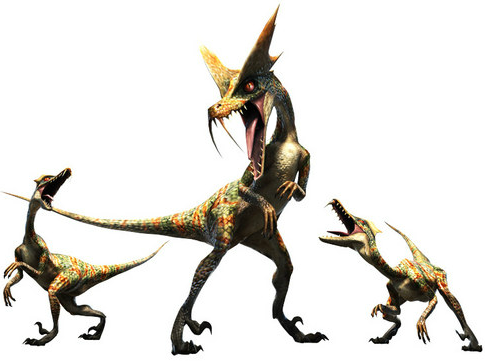
Ioprey
Ioprey have lithe, raptor-esque bodies. They have vivid red skin, with some black markings and purplish lavender colouration by the limbs.
Living in very unlikely places, such as the volcano. Poison sacs are located in its mouth below its crest, which are used to spit poison at foes, in order to kill it faster. Unlike its fellow raptors, the Ioprey does not possess the large claw, long fangs, or sharp claws on its forelimbs and back legs. Instead, the Ioprey relies solely on its poison, strength, and poison-filled fangs. Ioprey have poison-filled scales on their body make many predators think twice before attacking them. E
Iodrome
It is significantly larger than normal Ioprey and possesses a larger crest. Unlike other pack leaders, Iodrome has a more amphibian look, with salamander-like skin that seems to glisten with moisture, and a frog-like throat sac.
Iodrome have a poison sac inside their throat that allows them to spit toxic poison at prey. This has also made their small fangs poisonous when biting into prey. Even their scales and bones are filled with poison for defense against predators. The Iodrome is territorial known as a deadly trouble for miners as it loves tunnels. It will attack any threats on sight, however, they will back off if the threat is to big for them to handle.
Ioprey
Medium beast (theropod), unaligned
- Armor Class 11 (natural armor)
- Hit Points 22 (4d8 + 4)
- Speed 30 ft.
STR DEX CON INT WIS CHA 14 (+2) 11 (+0) 12 (+1) 2 (-4) 8 (-1) 6 (-2)
- Senses passive Perception 9
- Languages -
- Challenge 1/2 (100 XP)
Aggressive. As a bonus action, the ioprey can move up to its speed toward a hostile creature that it can see.
Actions
Bite. Melee Weapon Attack: +4 to hit, reach 5 ft., one target. Hit: 5 (1d6 + 2) piercing damage. If the target is a creature, it must succeed on a DC 13 Constitution saving throw or become Poisoned for 1 minute. A creature can repeat the saving throw at the end of each of its turns, ending the effect on itself on a success.
Claw. Melee Weapon Attack: +4 to hit, reach 5 ft., one target. Hit: 7 (2d4 + 2) slashing damage.
Iodrome
Large beast (theropod), unaligned
- Armor Class 15 (natural armor)
- Hit Points 53 (7d10 + 14)
- Speed 40 ft.
STR DEX CON INT WIS CHA 17 (+3) 13 (+1) 15 (+2) 2 (-4) 10 (+0) 6 (-2)
- Skills Athletics +5
- Senses passive Perception 10
- Languages -
- Challenge 1 (200 XP)
Standing Leap. The iodrome's long jump is up to 30 feet and its high jump is up to 15 feet, with or without a running start.
Aggressive. As a bonus action, the iodrome can move up to its speed toward a hostile creature that it can see.
Actions
Bite. Melee Weapon Attack: +5 to hit, reach 5 ft., one target. Hit: 12 (2d8 + 3) piercing damage. If the target is a creature, it must succeed on a DC 13 Constitution saving throw or become Poisoned for 1 minute. A creature can repeat the saving throw at the end of each of its turns, ending the effect on itself on a success.
Poison Spit. The iodrome spits a poisonous concoction at a 5 foot area within 60 feet. All creatures within a 5 foot radius of the area must pass a DC 13 Constitution saving throw, taking 7 (2d6) poison damage and become poisoned for 1 minute. A creature can repeat the saving throw at the end of each of its turns, ending the effect on itself on a success.
Alpha Call (1/day). The iodrome calls out for help and 1d4 ioprey appears to assist it.
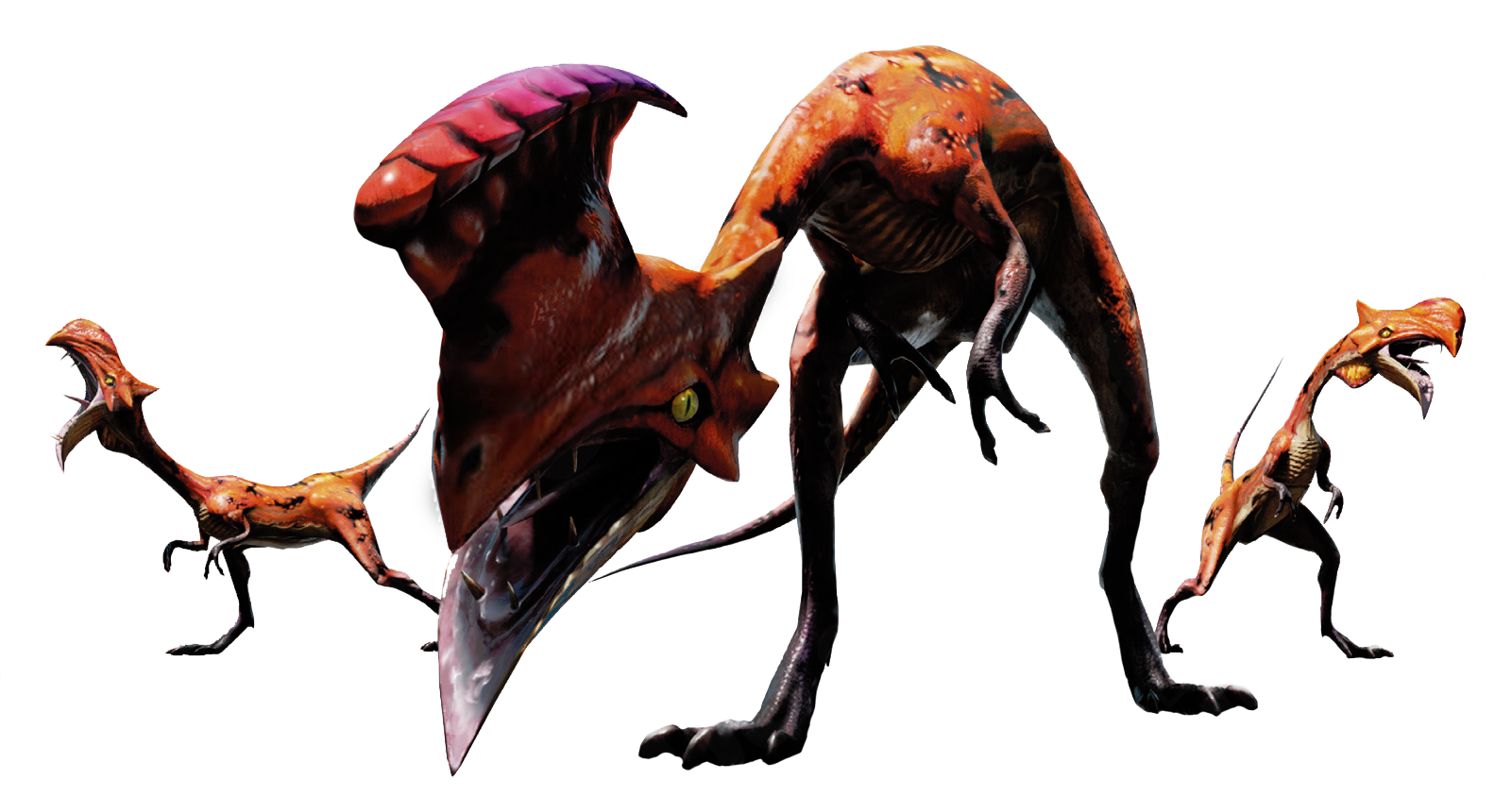
Giaprey
have crystal blue scales with sky blue stripes. As to the other relatives of the Giaprey it is able to take high amounts of cold. This is because of the skin being warmer than its blood and is able to repel high amounts of the cold in the Snowy Mountains.
Giapreys live in packs and obey their leader the Giadrome in what it dictates to the pack. Though they are small they are very aggressive if someone enter their territory.
Giadrome
It is physically very similar to the Velocidrome, the only key difference being the pale blue colouration and the presence of a frost sac. From the scales of Giadrome being white and blue, they are able to blend into the snow. This allows it to hunt better in the cold. Unlike the other species of Velociprey, Giadrome can spit a freezing cold liquid at prey. This spit can freeze in prey in their tracks. Their fangs are very cold and sharp to the touch.
Giadrome are quite social compared to its cousins. Unlike most other Velociprey species, Giadrome and Giaprey are quite social. They are known to be made up of more than one pack. Both Giadrome will live together and even control each other's pack while together. By being together, their packs are much deadlier and larger than before.
Giaprey
Medium beast (theropod), unaligned
- Armor Class 10 (natural armor)
- Hit Points 16 (3d8 + 3)
- Speed 30 ft.
STR DEX CON INT WIS CHA 12 (+1) 11 (+0) 12 (+1) 2 (-4) 8 (-1) 6 (-2)
- Damage Resistances cold
- Senses passive Perception 9
- Languages -
- Challenge 1/2 (100 XP)
Ice Walk. The giaprey can move across and climb icy surfaces without needing to make an ability check. Additionally, difficult terrain composed of ice or snow doesn't cost it extra moment.
Aggressive. As a bonus action, the giaprey can move up to its speed toward a hostile creature that it can see.
Actions
Bite. Melee Weapon Attack: +3 to hit, reach 5 ft., one target. Hit: 4 (1d6 + 1) piercing damage plus 2 (1d4) cold damage.
Claw. Melee Weapon Attack: +3 to hit, reach 5 ft., one target. Hit: 6 (2d4 + 1) slashing damage.
Giadrome
Large beast (theropod), unaligned
- Armor Class 14 (natural armor)
- Hit Points 45 (6d10 + 12)
- Speed 40 ft.
STR DEX CON INT WIS CHA 16 (+3) 13 (+1) 15 (+2) 2 (-4) 10 (+0) 6 (-2)
- Skills Athletics +5
- Damage Resistances cold
- Senses passive Perception 10
- Languages -
- Challenge 2 (450 XP)
Standing Leap. The giadrome's long jump is up to 30 feet and its high jump is up to 15 feet, with or without a running start.
Ice Walk. The giadrome can move across and climb icy surfaces without needing to make an ability check. Additionally, difficult terrain composed of ice or snow doesn't cost it extra moment.
Aggressive. As a bonus action, the giadrome can move up to its speed toward a hostile creature that it can see.
Actions
Bite. Melee Weapon Attack: +5 to hit, reach 5 ft., one target. Hit: 12 (2d8 + 3) piercing damage plus 3 (1d6) cold damage.
Ice Spit (Recharge 5-6}. Ranged Weapon Attack: +3 to hit, range 30/60 ft., one creature. Hit: The target is restrained by ice. As an action, the restrained target can make a DC 11 Strength check, bursting the ice on a success. The ice can also be attacked and destroyed (AC 10; hp 5; vulnerability to fire and bludgeoning damage; immunity to slashing, poison, and psychic damage).
Alpha Call (1/day). The giadrome calls out for help and 1d4 giaprey appears to assist it.
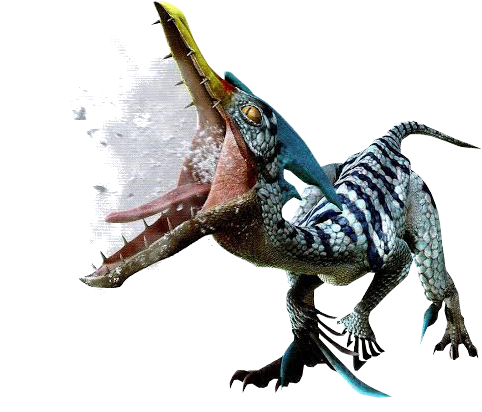
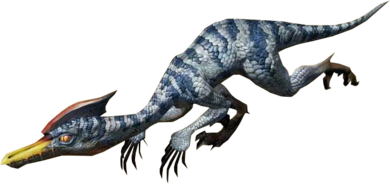
Maccao & Great Maccao
The Great Maccao feathered crest sets them apart from its Maccao pack. Although superficially similar to its younger brethren, a Great Maccao is bigger and bulkier, with more brightly-colored plumage. It also has powerful legs it uses to kick threats and to move with great speed, and its spiked tail allows it to propel itself forward and jump with tremendous force.
Only male Maccaos or Great Maccaos have feathers on their head. A Maccao's tail is similar a kangaroo's tail. Its tail allows it to propel itself forward and jump with tremendous force. The Maccao has the ability to stand on its tail without any support from its legs, allowing it to balance itself on its tail with its legs in the air. While standing on its tail, its bright, red underbelly is revealed. The red underbelly acts as a warning sign, and is used to intimidate predators.
Maccao are scavengers that feed on corpses and eggs belonging to larger predators. Though primarily scavengers, Great Maccao will also feed on smaller monster species.
Great Maccao are shy monsters that prefer to stay away from most threats. Despite Great Maccao being the leader of its Maccao pack, it barely has any control over its lesser counterparts, unlike other Bird Wyverns such as the Great Jaggi. A Great Maccao's pack will rarely assist it in if it is in danger. Great Maccao would rather run than fight, much like its smaller counterparts.
Maccao
Medium beast (theropod), unaligned
- Armor Class 11 (natural armor)
- Hit Points 22 (4d8 + 4)
- Speed 30 ft.
STR DEX CON INT WIS CHA 13 (+1) 10 (+0) 13 (+1) 3 (-4) 8 (-1) 6 (-2)
- Senses passive Perception 9
- Languages -
- Challenge 1/4 (50 XP)
Aggressive. As a bonus action, the maccao can move up to its speed toward a hostile creature that it can see.
Actions
Bite. Melee Weapon Attack: +3 to hit, reach 5 ft., one target. Hit: 4 (1d6 + 1) piercing damage.
Tail. Melee Weapon Attack: +3 to hit, reach 5 ft., one target. Hit: 5 (1d8 + 1) bludgeoning damage.
Great Maccao
Large beast (theropod), unaligned
- Armor Class 14 (natural armor)
- Hit Points 52 (7d10 + 14)
- Speed 40 ft.
STR DEX CON INT WIS CHA 16 (+3) 13 (+1) 14 (+2) 2 (-4) 11 (+0) 6 (-2)
- Senses passive Perception 10
- Languages -
- Challenge 2 (450 XP)
Standing Leap. The great maccao's long jump is up to 40 feet and its high jump is up to 20 feet, with or without a running start.
Actions
Multiattack. The great maccao makes two Kick attacks.
Kick. Melee Weapon Attack: +5 to hit, reach 5 ft., one target. Hit: 9 (2d6 + 2) bludgeoning damage.
Deadly Leap. If the great maccao jumps at least 15 feet as part of its movement, it can then use this action to land on its feet in a space that contains one or more other creatures. Each of those creatures must succeed on a DC 12 Strength or Dexterity saving throw (target's choice) or be knocked prone and take 11 (2d8 + 2) bludgeoning damage On a successful save, the creature takes only half the damage, isn't knocked prone, and is pushed 5 feet out of the great maccao's space into an unoccupied space of the creature's choice. If no unoccupied space is with in range, the creature instead falls prone in the great maccao's space.
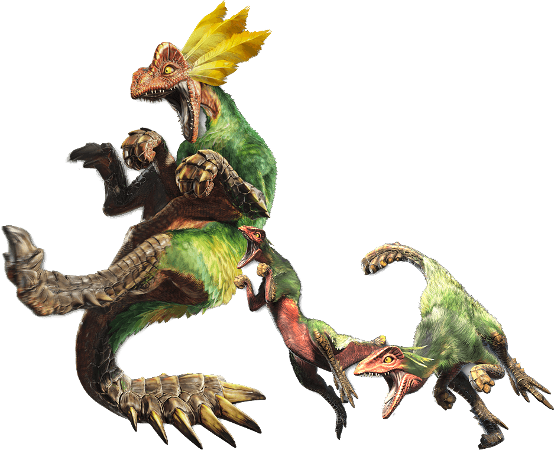
Kulu-Ya-Ku
Kulu-Ya-Ku has a body shape similar to other raptorial Bird Wyverns, such as Velocidrome. This monster is covered in light brown scales and has a face that greatly resembles a Dodo. Though it is mostly covered in scales, it also has feathers on its head and arms.
Kulu-Ya-Ku is able to pick up small boulders and use them to protect itself from incoming attacks. It can also toss said boulders at foes from a distance.
Kulu-Ya-Ku
Large beast (theropod), unaligned
- Armor Class 13 (natural armor)
- Hit Points 119 (14d10 + 72)
- Speed 40 ft.
STR DEX CON INT WIS CHA 17 (+3) 14 (+2) 16 (+3) 8 (-1) 10 (+0) 9 (-1)
- Saving Throws Dex +5, Con +6, Cha +2
- Senses passive Perception 10
- Languages -
- Challenge 4 (1,100 XP)
Pounce. If the kulu-ya-ku moves at least 20 feet straight toward a creature and then hits it with a peck Attack on the same turn, that target must succeed on a DC 14 Strength saving throw or be knocked prone. If the target is prone, the kulu-ya-ku can make one claw Attack against it as a Bonus Action.
Standing Leap. The kulu-ya-ku's long jump is up to 20 feet and its high jump is up to 10 feet, with or without a running start.
Actions
Multiattack. The kulu-ya-ku makes two attacks: one peck attack, one claw attack.
Peck. Melee Weapon Attack: +5 to hit, reach 5 ft., one target. Hit: 10 (2d6 + 3) piercing damage.
Claw. Melee Weapon Attack: +5 to hit, reach 5 ft., one target. Hit: 10 (2d6 + 3) slashing damage or 12 (2d8 + 3) bludgeoning damage while it has a boulder.
Dig (recharge 6). The kulu-ya-ku digs into the ground pulling out a small sized boulder that it wields in its claws. It will carry around the boulder until it takes thunder damage; becomes blinded, stunned, or paralyzed; or uses its boulder toss attack.
Boulder Toss (requires Boulder). Range Weapon Attack: +5 to hit, range 20/60 ft., one target. Hit 16 (3d8 + 3) bludgeoning damage.
Reactions
Parry. The kulu-ya-ku adds 3 to its AC against one melee attack that would hit it. To do so, the kulu-ya-ku must see the attacker and be wielding a boulder.
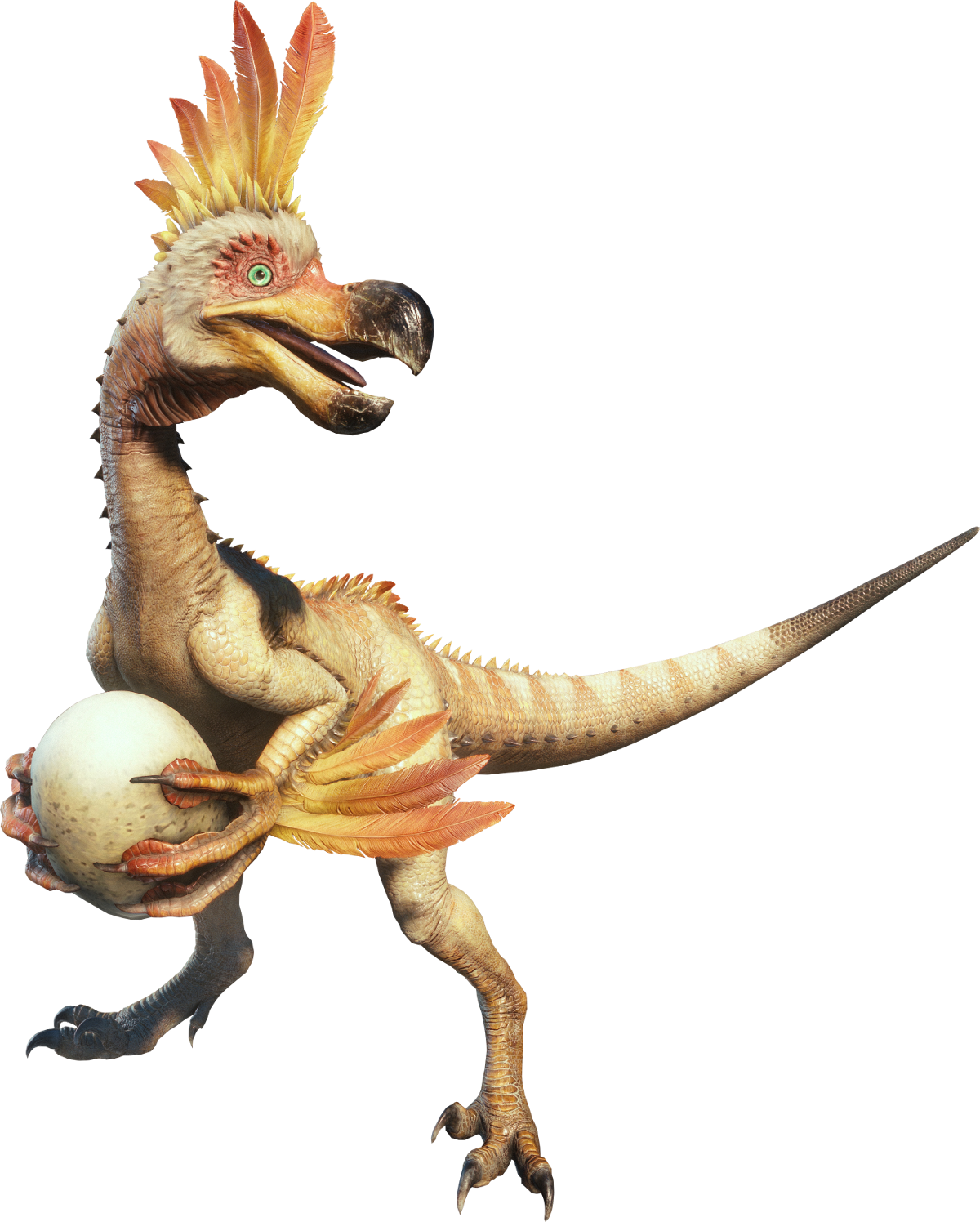
Tzitzi-Ya-Ku
Large beast (theropod), unaligned
- Armor Class 15 (natural armor)
- Hit Points 127 (15d10 + 45)
- Speed 40 ft.
STR DEX CON INT WIS CHA 19 (+4) 14 (+2) 16 (+3) 8 (-1) 10 (+0) 9 (-1)
- Saving Throws Dex +5, Int +2, Cha +2
- Senses passive Perception 10
- Languages -
- Challenge 6 (2,300 XP)
Pounce. If the tzitzi-ya-ku moves at least 20 feet straight toward a creature and then hits it with a bite Attack on the same turn, that target must succeed on a DC 15 Strength saving throw or be knocked prone. If the target is prone, the tzitzi-ya-ku can make one talon Attack against it as a Bonus Action.
Standing Leap. The tzitzi-ya-ku's long jump is up to 20 feet and its high jump is up to 10 feet, with or without a running start.
Actions
Multiattack. The tzitzi-ya-ku makes two attacks: one bite attack and one with its talon
Bite. Melee Weapon Attack: +7 to hit, reach 5 ft., one target. Hit: 13 (2d8 + 4) piercing damage.
Talon. Melee Weapon Attack: +7 to hit, reach 5 ft., one target. Hit: 11 (2d6 + 4) slashing damage.
Tail. Melee Weapon Attack: +7 to hit, reach 5 ft., one target. Hit: 13 (2d8 + 4) bludgeoning damage.
Flash (recharge 5-6). The tzitzi-ya-ku emits a bright flash of light from the fins on its head in a 60-foot cone. Each creature in that area must succeed on a DC 14 Constitution saving throw or become blinded for 1 minute. A creature that fails the roll by 5 or more is also stunned until the end of their next turn.
Legendary Actions
The tzitzi-ya-ku can take 2 legendary actions, choosing from the options below. Only one legendary action option can be used at a time and only at the end of another creatures turn. The tzitzi-ya-ku regains spent legendary actions at the start of its turn.
Move. The tzitzi-ya-ku moves up to its speed without provoking opportunity attacks.
Talon. The tzitzi-ya-ku makes one Talon attack.
Tzitzi-Ya-Ku
Tzitzi-Ya-Ku is a theropod of a navy blue coloration. It has long, powerful back legs, and muscular forelegs complete with three claws for grasping prey. Perhaps its most unique feature is the pair of retractable frills that line either side of its head, which are bright and vividly colorful in appearance. Its back is lined with a row of short spines, and it has wide, sturdy feet.
Tzitzi-Ya-Ku is able to emit bright flashes of light from the fins on the sides of its head. This can be used to disorient attackers and prey alike, allowing the monster to gain the upper hand in combat. Its powerful hind legs can be used to deliver potent kicks during battle.
This monster is comparatively low on the food chain, so it uses the dark colouration of its body to blend in and stalk its prey amongst the shadowy undergrowth of the Coral Highlands, far below the jurisdiction of the powerful Wyverns that rule the local ecosystem.
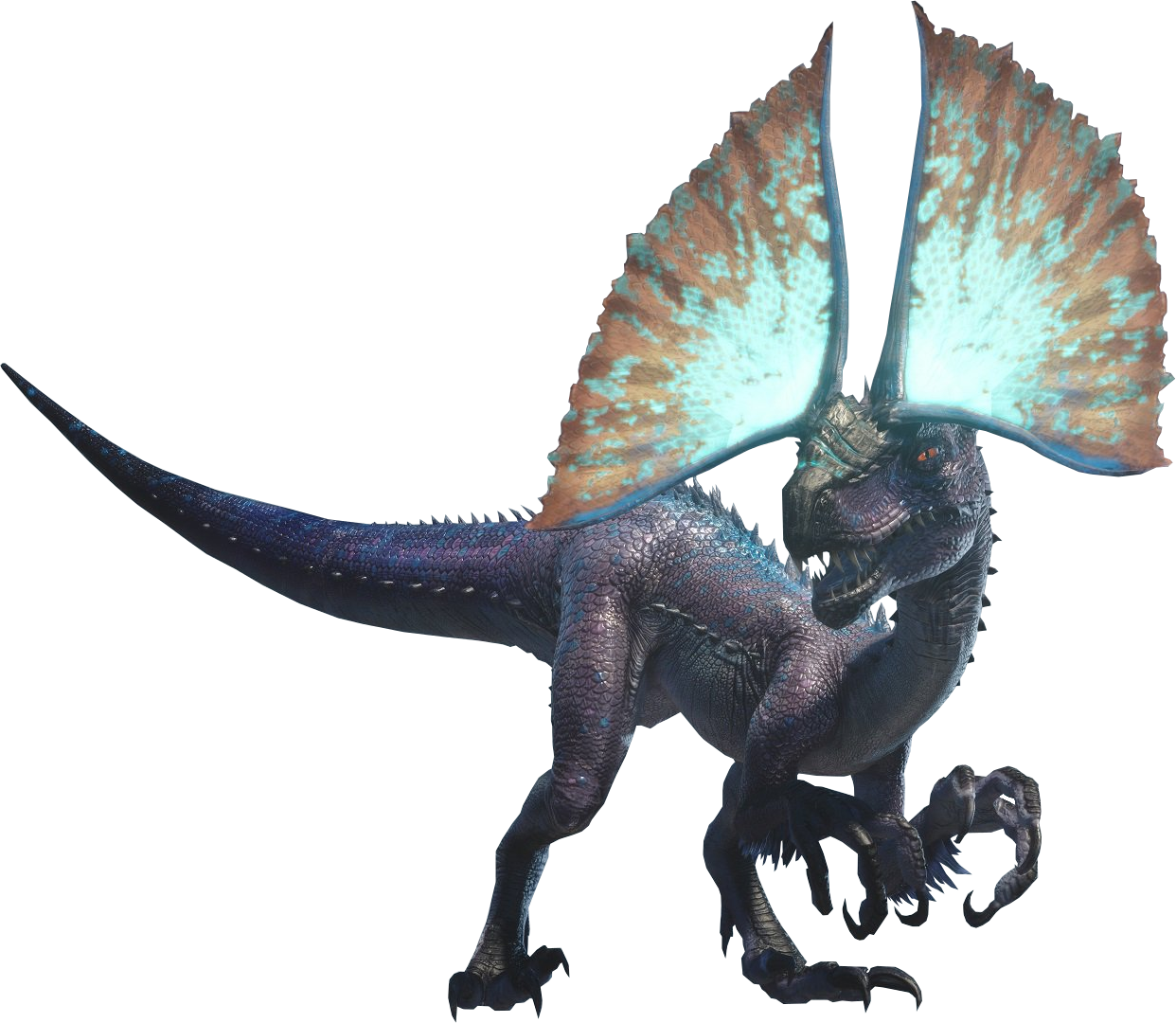
Yian Kut-Ku
The Yian Kut-Ku is characterized by its large, fan-like ears that unfurl when excited. They have a large, yellow beak with a pink stripe running down its length. The lower jaw of its beak is significantly bigger than the top jaw. Yian Kut-Ku's body is covered in orange-pink plating and beige scales. Its wing membranes are deep blue and its eyes are bright yellow. These wyverns are small and relatively light, making them quick and agile. They have an extremely powerful sense of hearing, thanks to their large ears.
A somewhat temperamental, skittish, and inquisitive wyvern. Yian Kut-Ku have a tendency to want to appear bigger than they really are by spreading their wings, flaring out their ears, and squawking loudly. They are generally insectivores, preying on Konchu and other Neopterons as a main part of their diet.
Yian Kut-Ku are capable of flight, which is a major advantage when fleeing from large terrestrial predators. However, they aren't as adept in the air when compared to other wyverns. Due to this Kut-Ku spend more time on land. Kut-Ku have very large and sturdy beaks used to crush hard-shelled prey and fruit, as well as aid them in shoveling up ground-dwelling insects and larvae. This is particularly visible when it is feeding on Konchus, as it can bypass their hard shells by simply scooping the Neopterons up when they roll into balls and swallowing them whole.
The most defining trait of Yian Kut-Ku are their specialized large ears. These ears are very sensitive to sound and sudden loud noises can disorient them leaving them vulnerable to attack, thus causing hunters to often use Sonic Bombs when hunting these creatures.
Yian Kut-Ku are omnivorous creatures that eat a wide variety of different things. Kut-Ku will eat lots of insects, such as Konchu, nuts and honey. While they are fully capable of defending themselves against smaller predators such as Velocidrome and their packs Kut-Ku are often preyed upon by larger predators like Rathian, Abiorugu, Najarala and Pariapuria. Kut-Ku are well known for getting into territorial conflicts with the extremely aggressive Yian Garuga.
Sometimes a Garuga will take over a Kut-Ku's territory and even kill the smaller bird wyvern. Female Yian Garuga will also destroy the eggs of a Kut-Ku and lay their own eggs in the nest, leaving the Kut-Ku as a victim of brood parasitism.
Yian Kut-ku
Large wyvern (bird), unaligned
- Armor Class 13 (natural armor)
- Hit Points 75 (10d10 + 20)
- Speed 30 ft., fly 30 ft.
STR DEX CON INT WIS CHA 14 (+2) 16 (+3) 14 (+2) 8 (-1) 12 (+1) 6 (-2)
- Skills Perception +4
- Senses passive Perception 14
- Languages -
- Challenge 3 (700 xp)
Sensitive Ears. If the yian kut-ku takes thunder damage or a thunder spell is used within 60 feet of it, it is stunned until the start of its next turn.
Charge. If the yian kut-ku moves at least 20 feet straight toward a target and then hits it with a Body Slam Attack on the same turn, the target takes an extra 19 (3d12) bludgeoning damage. If the target is a creature, it must succeed on a DC 13 Strength saving throw or be knocked prone.
Actions
Multiattack. The yian kut-ku makes three attacks: two peck attacks and one tail attack.
Peck. Melee Weapon Attack. +4 to hit, reach 5 ft., one target. Hit 11 (2d8 + 2) piercing damage.
Tail. Melee Weapon Attack. +4 to hit, reach 5 ft., one target. Hit 13 (2d10 + 2) bludgeoning damage.
Body Slam. Melee Weapon Attack. +4 to hit, reach 5 ft., one target. Hit 21 (3d12 + 2) bludgeoning damage.
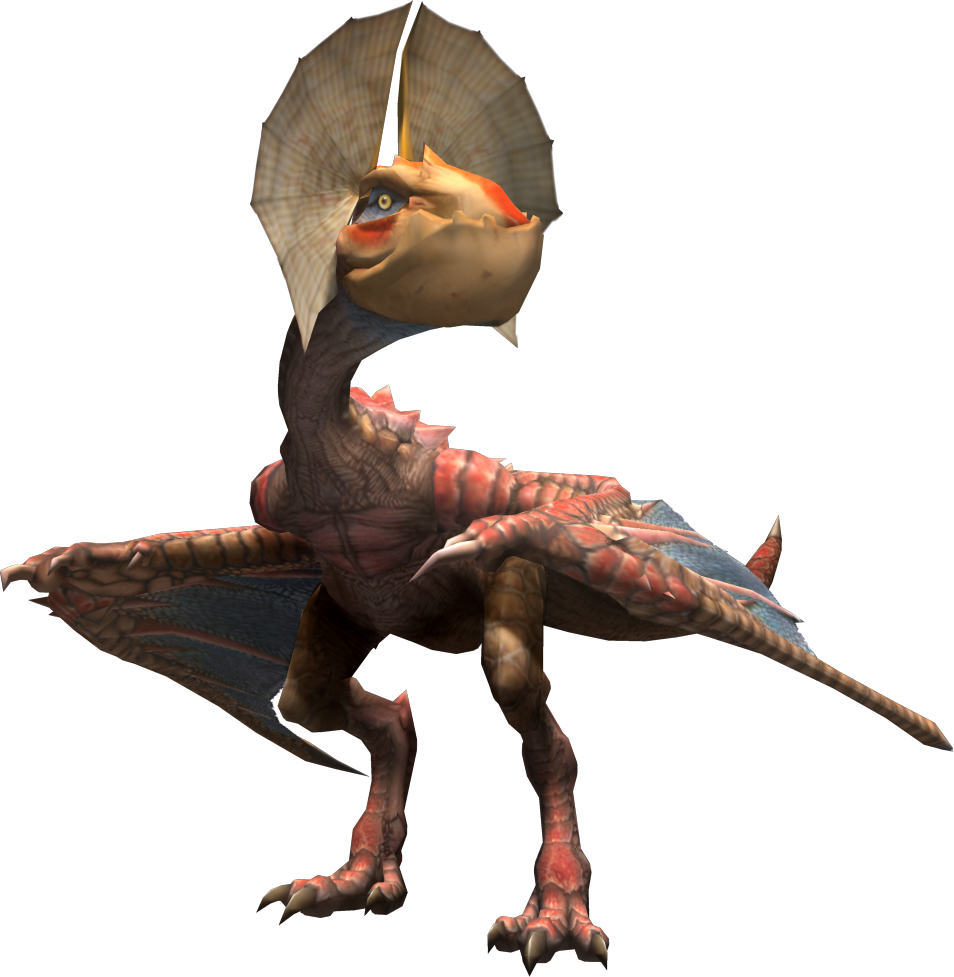
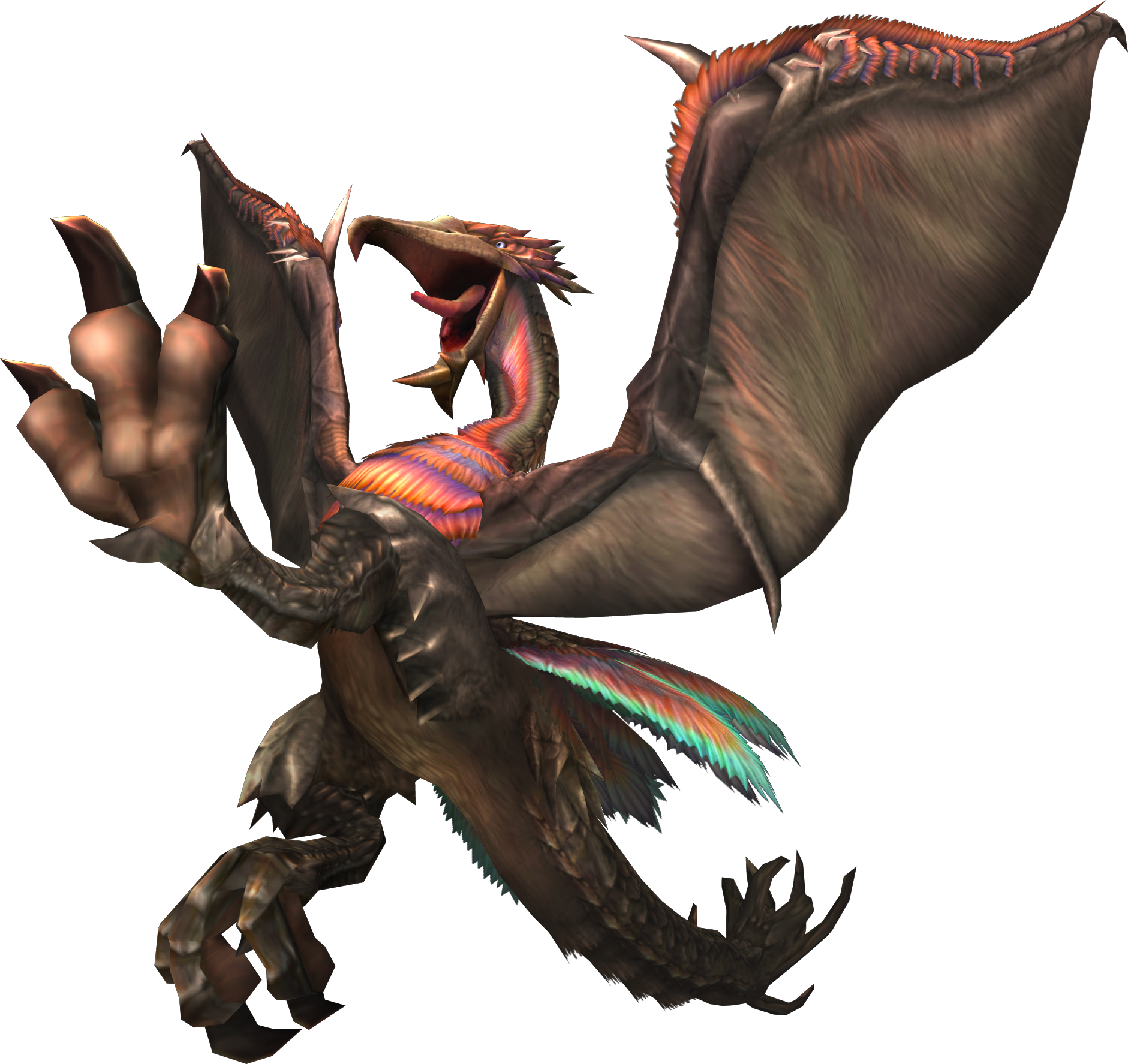
Hypnocatrice
Hypnocatrice is a large-sized Bird Wyvern covered in bright, colourful feathers. It has extremely powerful legs with large feet to deliver powerful kicks, and a hard, sharp beak. It is equipped with a sleeping sac that can put adventurers and other monsters to sleep and its small size and lightweight allow it to move with speed and agility during battle. Despite its feathered appearance, Hypnocatrice flies using bat-like, membraned wings, leaving its feather arrangements strictly for display purposes. Hypnocatrice is not particularly aggressive or territorial, but will stand its ground if threatened. They are typically found in lush environments such as the forest or jungle, but have also been encountered in desolate environments such as the desert.
Hypnocatrice
Large wyvern (bird), unaligned
- Armor Class 14 (natural armor)
- Hit Points 105 (14d10 + 28)
- Speed 40 ft., fly 40 ft.
STR DEX CON INT WIS CHA 16 (+3) 12 (+1) 15 (+2) 9 (-1) 10 (+0) 7 (-2)
- Skills Athletics +6
- Condition Immunities incapacitated
- Senses passive Perception 10
- Languages -
- Challenge 4 (1,100 xp)
Actions
Multiattack. The hypnocatrice makes three attacks, two with its talons and one with its Peck attack.
Talons. Melee Weapon Attack: +5 to hit, reach 5 ft., one target. Hit 10 (2d6 + 3) bludgeoning damage.
Peck. Melee Weapon Attack. +5 to hit, reach 5 ft., one target. Hit 12 (2d8 + 3) bludgeoning damage.
Sleep Gas. (recharge 5-6). The hypnocatrice spits out a bubble of sleeping gas to a location within 30 feet. Upon impact, the bubble bursts releasing the gas in a 5-foot radius around it. Each creature in that area must make a DC 12 Constitution saving throw or, they fall Unconscious until the spell ends, the sleeper takes damage, or someone uses an action to shake or slap the sleeper awake.
Wing Attack (3/day). The hypnocatrice beats its wings. Each creature within 10 feet of the hypnocatrice must succeed on a DC 13 Dexterity saving throw or take 10 (2d6 + 3) bludgeoning damage and be knocked prone. The hypnocatrice can then fly up to half its flying speed.
Pukei-Pukei
Large wyvern (bird) , unaligned
- Armor Class 12 (natural armor)
- Hit Points 97 (13d10 + 26)
- Speed 30 ft., fly 30 ft.
STR DEX CON INT WIS CHA 17 (+3) 15 (+2) 15 (+2) 3 (-4) 11 (+0) 10 (+0)
- Saving Throws Con +4, Wis +2, Cha+2
- Senses passive Perception 10
- Languages -
- Challenge 4 (1,100 xp)
Diet. A creature that is poisoned by the pukei-pukei suffers from an additional effects based on what its eaten. Roll 1d4, the number determines the additional condition of its poison. On a 1, stunned; On a 2, deafened; On a 3, paralyzed; On a 4, blinded.
Actions
Multiattack. The pukei-pukei makes two tongue attacks and one tail attack. It can replace any one of these with its poison spit attack.
Tongue. Melee Weapon Attack. +5 to hit, reach 10 ft., one target. Hit 14 (2d10 + 3) piercing damage.
Tail. Melee Weapon Attack. +5 to hit, reach 5 ft., one target. Hit 12 (2d8 + 3) bludgeoning damage.
Poison Spit. Range Weapon Attack: +4 to hit, range 30/120 ft., one target. Hit: 10 (3d6) poison damage and the target must pass a DC 13 Constitution saving throw, or become poisoned for 1 minute. A creature can repeat the saving throw at the end of each of its turns, ending the effect on itself on a success.
Poison Spray (Recharge 5-6). The pukei-pukei sprays poisonous gas from its tail in a 30-foot cone. Each creature in that area must make a DC 13 Constitution saving throw, or become poisoned and take 27 (6d8) poison damage on a failed save, or half as much damage and are not poisoned on a successful one.
Pukei-Pukei
Pukei-Pukei slightly resembles a chameleon, and its eyes are similar to frogs. It has a pair of wings and is covered in green scales that vary in color throughout its body excluding its underbelly. Its underbelly is covered in white osteoderm-like protrusions. Despite being reptilian in nature, Pukei-Pukei has vibrant feathers around its neck and wings.
Pukei-Pukei is known to store the properties of its food within its mouth and tail before combining them with its own poison. By doing so, it can spew poison from its mouth and tail for protection. This poison varies depending on its previous meal.
Pukei-Pukei is known to bully smaller monsters, but will flee from larger ones.
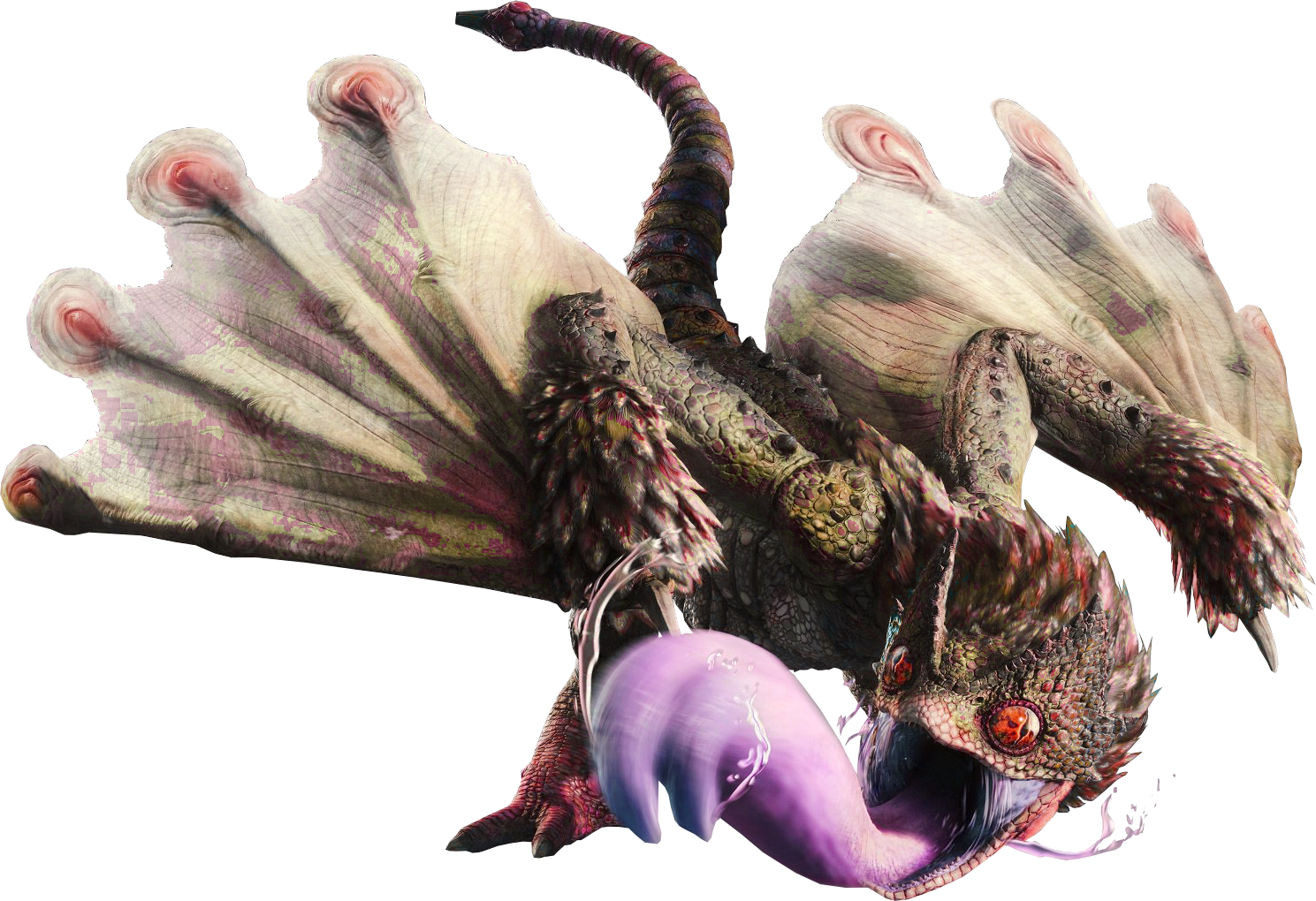
Qurupeco
The Qurupeco resembles a large bird with Pterosaur-like features, such as a fanged beak and leathery wings. It is mainly green colored with some scales being tinted yellow, it also has a clump of iridescent purple feathers on its back between its shoulders. The Qurupeco has a short, stubby brown crest extending from the back of its head. It uses its masterful vocal mimicry abilities to call for aid from various monsters, as well as healing them and boosting their abilities. The Qurupeco's soft crest stretches over the top of its head and when calling opens out into the shape of a megaphone, amplifying its calls. Its most notable feature however is its bright red vocal sac which inflates when calling.
The Qurupeco also has a pair of thick, bulky growths on its wings which produce sparks when struck against each other, much like flints. It uses these to ignite its mucus, causing fiery explosions. Its tail is shaped like a fan and can unfold revealing brightly colored skin, most likely as a warning for any would-be attacker. The Qurupeco's feet seem to have only 3 frontal digits on each foot. It may also have a back digit, but its stubby appearance makes it looks more like a heel. Its feet are also partially webbed.
Qurupeco
Large wyvern (bird), unaligned
- Armor Class 17 (natural armor)
- Hit Points 135 (18d10 + 36)
- Speed 30 ft., fly 30 ft., swim 40 ft.
STR DEX CON INT WIS CHA 14 (+2) 16 (+3) 15 (+2) 7 (-2) 14 (+2) 16 (+3)
- Saving Throws Cha +6
- Skills Performance +6
- Damage Resistances: fire
- Senses passive Perception 12
- Languages -
- Challenge 6 (2,300 xp)
Sensitive Ears. The qurupeco ears are very sensitive, Thunder skills or spells used within 60 feet of the qurupeco cause it to be Stunned until the start of its next turn.
Innate Spellcasting: The qurupeco's spellcasting ability is Charisma (spell save DC 14). It can innately cast the following spells, requiring no material components:
At Will: blade ward, cure wounds, vicious mockery
Actions
Multiattack. The qurupeco makes three attacks, one with its Flint and two with its Peck.
Peck. Melee Weapon Attack: +6 to hit, reach 5 ft., one target. Hit 12 (2d8 + 3) slashing damage.
Flint. The qurupeco leaps 5 feet towards a target creature striking together its flint-like wingtips creating a small explosion. The target must make a DC 14 Dexterity saving throw, taking 11 (2d10) fire damage on failed save, or half as much on a successful one.
Call for Aid (1/day). The qurupeco calls out for assistance, roll a d6; If 1-2, 1d4 Jaggi appear; if 3-4, a Great Jaggi appears; if 5-6 a Royal Ludroth appears.
Crimson Qurupeco
Unlike the normal variety, this subspecies is red and blue in color. The electric flints are unique to this subspecies. They also call upon aid from much stronger monsters. A Crimson Qurupeco uses the same stats as a normal Qurupeco, except for the changes listed below:
- Flint damage is changed to lightning damage.
- Call for Aid (1/day). The qurupeco calls out for assistance, roll a d6; If 1-2, a Royal Ludroth appears; if 3-4, a Rathian appears; if 5, a Nargacuga appears; if 6, a Deviljho appears.
The threat from this variant is increased due to the allies it can summon to its aid. It is not recommended to use this variant until the players are able survive a CR 11 deadly encounter.
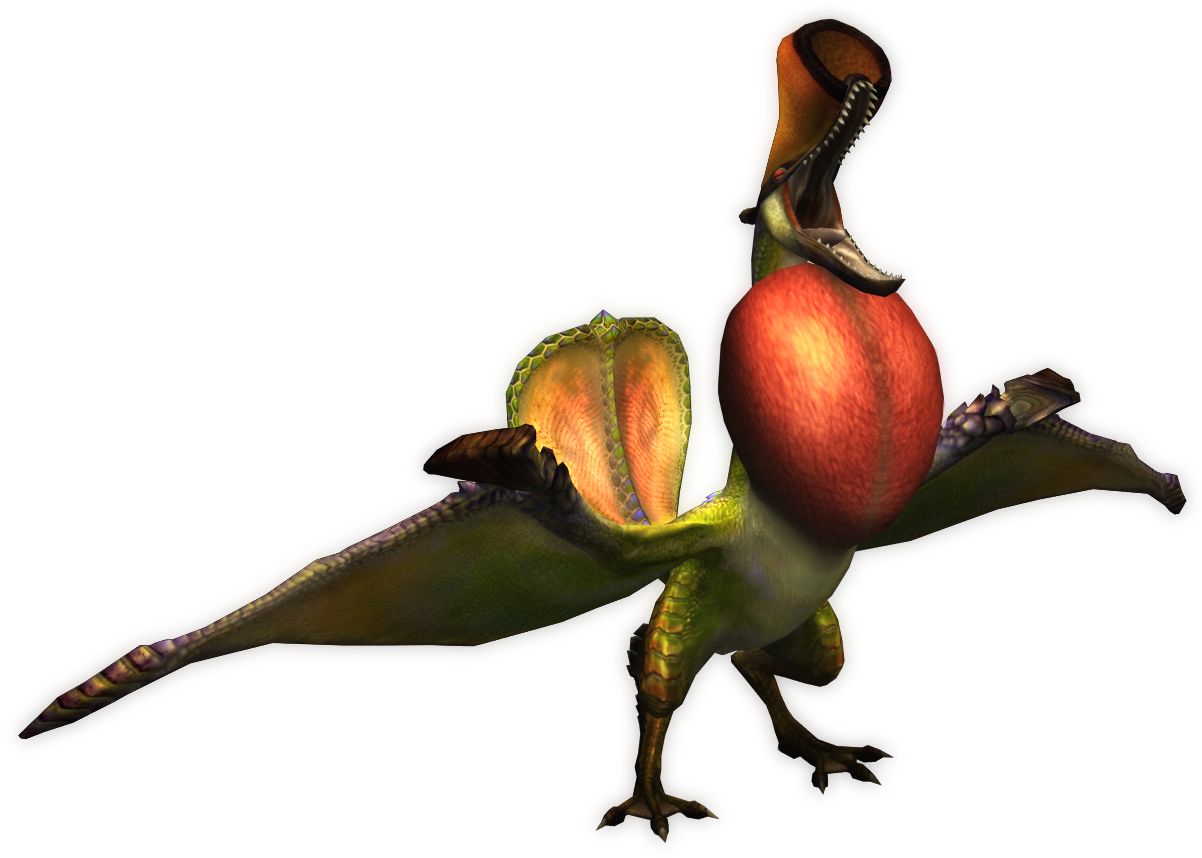
Yian Garuga
Large wyvern (bird), unaligned
- Armor Class 16 (natural armor)
- Hit Points 142 (15d10 + 60)
- Speed 30 ft., fly 30 ft.
STR DEX CON INT WIS CHA 15 (+2) 21 (+5) 18 (+4) 14 (+2) 12 (+1) 8 (-1)
- Saving Throws Int +5
- Skills Perception +4 Acrobatics +8
- Senses darkvision 120 ft., passive Perception 14
- Languages -
- Challenge 7 (2,900 xp)
Sensitive Ears. If the yian garuga takes thunder damage or a thunder spell is used within 60 feet of it, it is stunned until the start of its next turn.
Flyby. The yian garuga doesn't provoke opportunity attacks when it flies out of an enemy's reach.
Actions
Multiattack. The yian garuga makes two Peck attacks and one tail attack.
Peck. Melee Weapon Attack. +8 to hit, reach 5 ft., one target. Hit 14 (2d8 + 5) piercing damage.
Tail. Melee Weapon Attack. +8 to hit, reach 5 ft., one target. Hit 16 (2d10 + 5) bludgeoning damage + 13 (3d8) poison damage.
Violent Roar (Recharge 5-6). The yian garuga roars loudly in a 10-foot radius around them. All creatures in this area must make a DC 15 Constitution saving throw, taking 31 (7d8) thunder damage and become stunned until the end of its next turn on a failed saving throw. On a success the target takes half damage and is not Stunned.
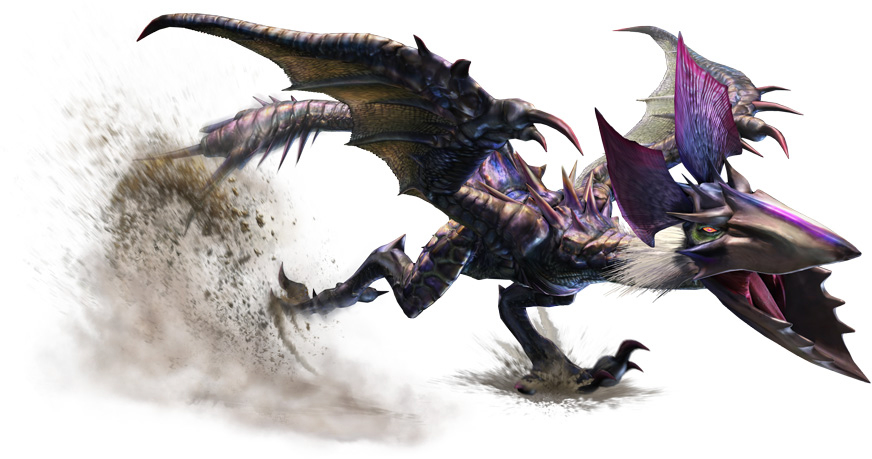
Yian Garuga
The Yian Garuga is highly aggressive Bird Wyvern that has a striking purple coloration, large defensive spikes and an extremely tough shell. Its beak is sharp and jagged, and it possesses a silver mane around the edge of its face.
Yian Garuga is a close relative of the Yian Kut-ku that possesses a poisonous tail club and can produce ear-splitting roars to stop foes in their tracks. It is quite crafty, and is known to rationally observe their prey, even when angered. They are not to be taken lightly.
Yian Garuga hunt almost exclusively at night, using its deadly poison or stabbing its prey with its sharp beak to finish off its victim. If hunting another predatory species such as a Velocidrome,
Very war-like in nature, Yian Garuga are a monster that is best avoided. Yian Garuga are very solitary creatures though, they have rarely been seen in groups possibly during a mating season, the groups consisting of more than two have been seen on islands. After mating, a female will sometimes seek out a Yian Kut-Ku nest, destroy the eggs, and then lay its own eggs in the nest for the oblivious Kut-Ku to raise and care for. This shows that a female Garuga can be a Brood Parasite like a real-world cuckoo bird. Yian Garuga perform this behavior due to their poor parental behavior.
Gypceros
Gypceros is among the largest and heaviest known Bird Wyverns. Its most notable features are the lamp-like crest on top of its head and a rubbery, shock-resistant hide. It has a long pink tail with a bulbous tip, and is a uniform blue-grey across most of its body. It possesses a poison sac which allows it to produce toxic fluids for use against attackers.
Gypceros can use its luminous crest to produce dizzying flashes and temporarily disorient foes. Its elastic tail can extend and be used as a whip, and it can spit large globules of poison to intoxicate attackers. Due to its shock-resistant hide and flashing crest, it is resistant to lightning attacks and to effects that would blind it.
Gypceros is a naturally timid wyvern. However, it is rather intelligent and crafty, as evidenced by its willingness to feign death in order to draw a foe in for a surprise attack.
Gypceros is usually found in swamps and marshlands, although it can occasionally be seen in jungles and open grasslands.
Gypceros
Large wyvern (bird), unaligned
- Armor Class 16 (natural armor)
- Hit Points 157 (15d10 + 75)
- Speed 30 ft., fly 30 ft.
STR DEX CON INT WIS CHA 18 (+4) 16 (+3) 20 (+5) 10 (+0) 12 (+1) 14 (+2)
- Saving Throws Con +8, Int +3, Wis +4
- Skills Performance +8, Deception +5
- Damage Resistances lightning
- Condition Immunities Blind
- Senses passive Perception 11
- Languages -
- Challenge 8 (3,900 xp)
Feign Death. When the gypceros makes a Charisma (Performance) check to appear dead. A creature can make a Intelligence (Investigation) check against the gypceros's performance to determine that it is alive. The gypceros is blinded and prone while under the effects of feign dead, but may still use its passive perception for hearing, smell, and touch. This effect lasts up to 1 hour or until the gypceros uses Thrash.
Actions
Multiattack. The gypceros makes three attacks, one with its Tail and two with its Peck.
Peck. Melee Weapon Attack: +7 to hit, reach 5 ft., one target. Hit 13 (2d8 + 4) piercing damage + 10 (3d6) poison damage.
Tail. Melee Weapon Attack. +7 to hit, reach 10 ft., one target. Hit 13 (2d8 + 4) bludgeoning damage.
Flash. (recharge 5-6). The gypceros lamp-like crest on top of its head creates a blinding flash of white light in a 45-foot radius. Each creature, except the gypceros, in that area must make a DC 16 Constitution saving throw or become blind for 1 minute. A creature may repeat the saving throw at the end of its turns, ending the effect.
Thrash. While using feign death, the gypceros can then use this action to strike each creature in a 5 foot radius around it by using all of its body parts. Each creature in that area must make a DC 15 Dexterity saving throw, taking 35 (10d6) and are knocked prone. On a successful save, the target takes half damage and is not knocked prone.
Reactions
Play Dead (3/day). When the gypceros is below half of its maximum hp and takes damage, it can use its reaction to feign death.
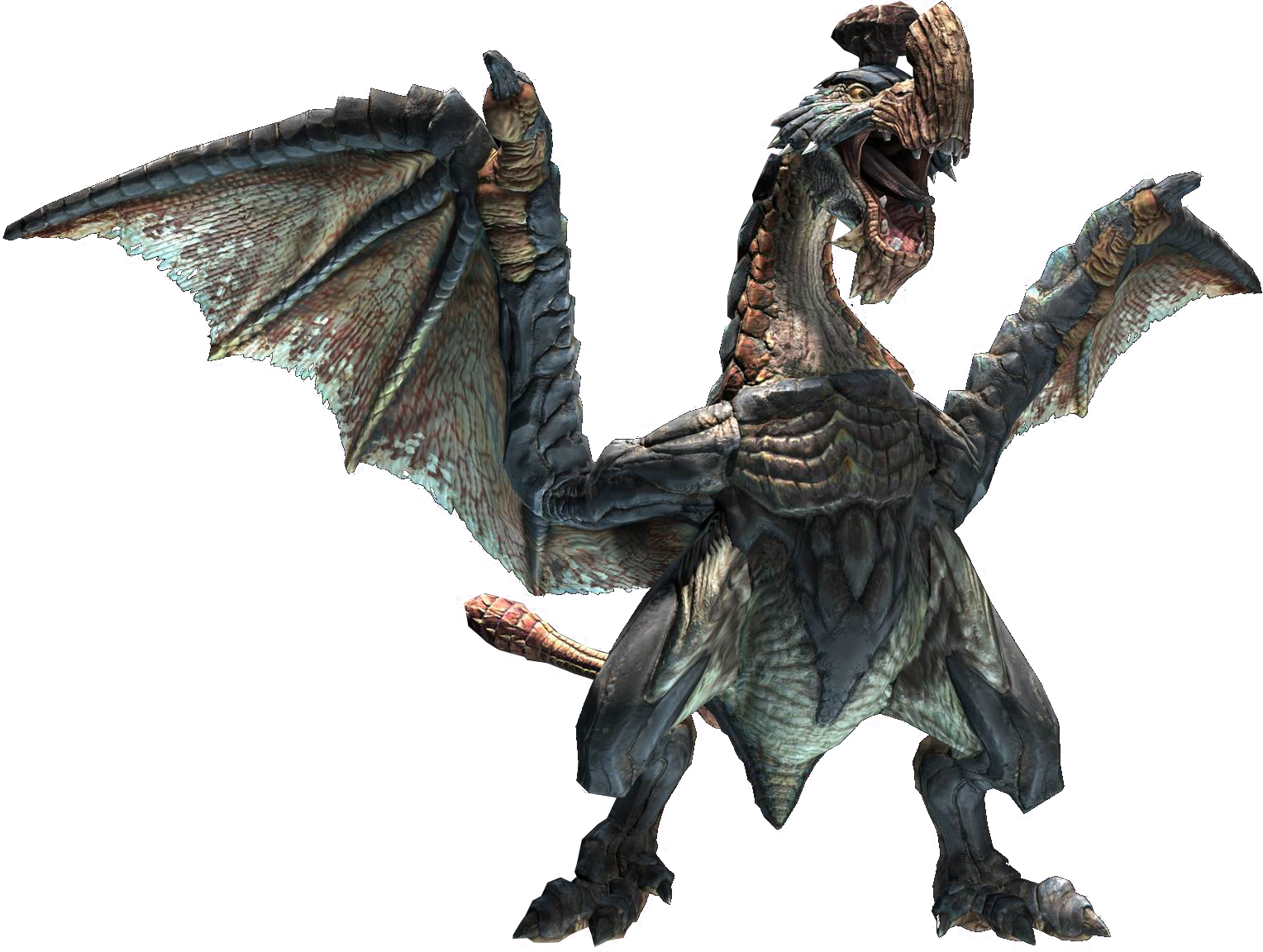
Malfestio
Large wyvern (bird), unaligned
- Armor Class 17 (natural armor)
- Hit Points 153 (18d10 + 54)
- Speed 30 ft., fly 40 ft.
STR DEX CON INT WIS CHA 17 (+3) 20 (+5) 16 (+3) 12 (+1) 16 (+3) 14 (+2)
- Skills Perception +7, Stealth +9
- Senses darkvision 120 ft., passive Perception 17
- Languages Giant Owl, understands Common, Elvish, and Sylvan but can't speak them
- Challenge 9 (5,000 xp)
Flyby. The malfestio doesn't provoke opportunity attacks when it flies out of an enemy's reach .
Keen Hearing and Sight. The malfestio has advantage on Wisdom (Perception) checks that rely on hearing or sight.
Magic Resistance. The malfestio has advantage on saving throws against spells and other magical effects.
Actions
Multiattack. The malfestio makes four attacks, two with its tail and two with its talons.
Talons. Melee Weapon Attack: +9 to hit, reach 5 ft., one target. Hit 14 (2d8 + 5) slashing damage.
Tail. Melee Weapon Attack. +9 to hit, reach 5 ft., one target. Hit 16 (2d10 + 5) slashing damage.
Sonic Wave. (recharge 5-6). The malfestio releases Sonic Wave in a 30 foot cone. Each creature in that area must make a DC 15 Wisdom saving throw or, they fall Unconscious until the spell ends, the sleeper takes damage, or someone uses an action to shake or slap the sleeper awake.
Malfestio
Malfestio superficially resembles an owl. Its body is covered in blue plumage with a grayish belly, a yellow collar, and a white face with a small beak and red eyes. On its head are long tufts that point back and are tipped with yellow. There are hints of yellow on its legs that end in scaly feet that have two talons and one small vestigial toe. Its wings have bright blue membranes. Along its wings are long blade-like claws. Its flattened tail ends in a three-pointed shape.
Malfestio is a nocturnal predator that uses its talons and wing claws to attack prey. Like Nargacuga, it sleeps in trees to avoid terrestrial predators. It can produce an ultrasound beam that can easily put prey to sleep. The claws along its wings are usually hidden but are revealed once the malfestio feels threatened.
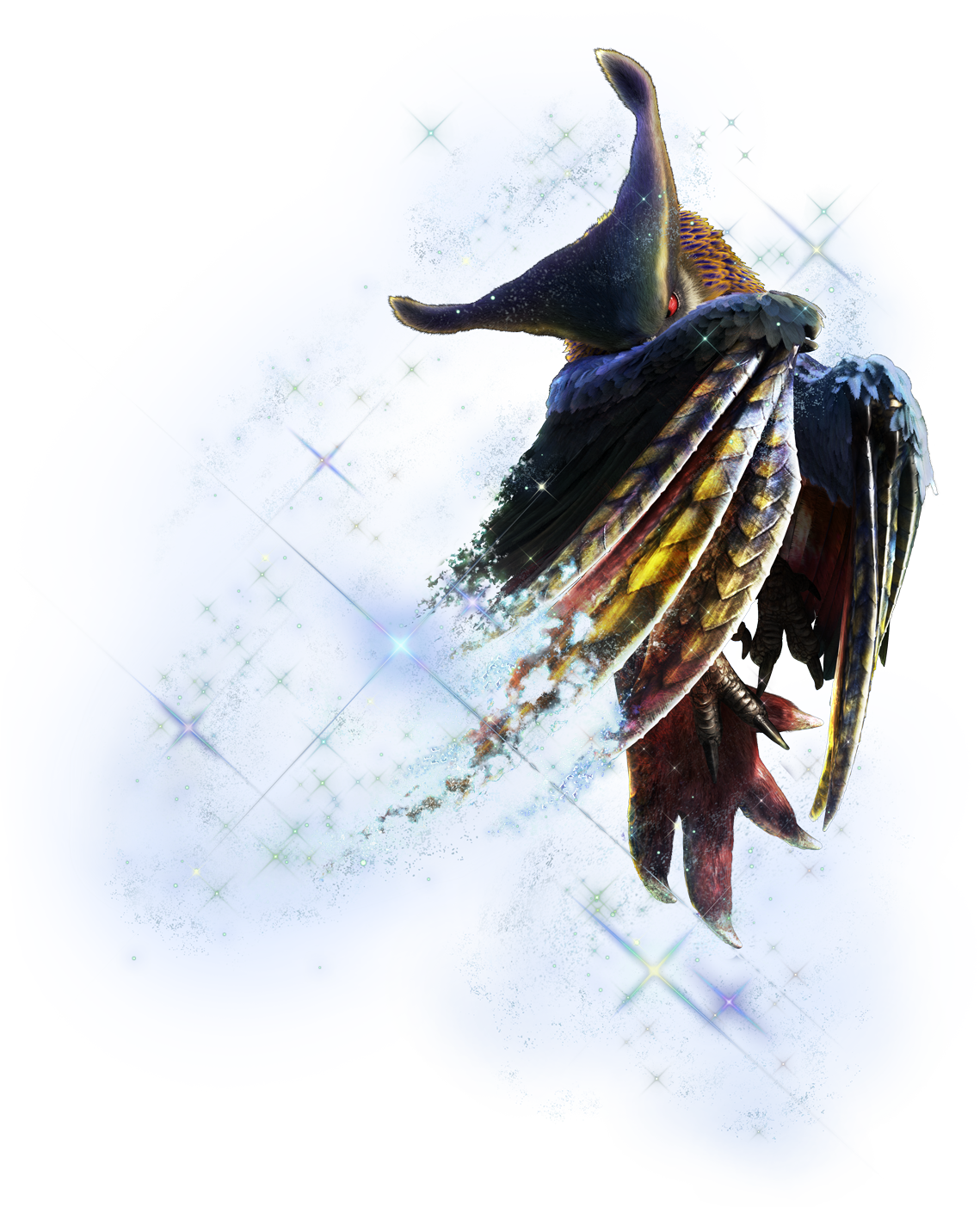

Thank you
For
Checking this out
Thank you all for using this Monster hunter Monster Manual. I created a few monsters originally because I wanted to use them in my own campaign and progressed into this Monster Manual we have today.
This section is 18 pages of monsters from the series and I am pretty proud to say I created them. I hope you all enjoy using these creatures as much as I plan too and this is not the end.
The Monster Manual might be done, but thanks to a few ideas from users on Reddit. I plan on creating a compendium with loot tables for materials, all of the weapons from the videogame series, and rules for using these monsters in your own Monster Hunter D&D game.
If you are interested in letting me know what you think. Feel free to stop by my Twitch channel or check out my Patreon. Thank you for reading and I hope this book serves you well.
Art
Most art, except the cover art, has been gathered from https://monsterhunter.wikia.com website and edited if needed to fit the page. The few others are listed below.
Lore
Most Lore, about these monsters, was also gathered from https://monsterhunter.wikia.com and then edited to omit any mention of missing skills and make the lore more in line with a D&D setting.